When you start to go beneath the surface of the Earth, you never know what you could uncover. The second-ever report of a fossilized flamingo egg in the world has been made, next to a construction site for a new airport in Mexico. Recently, digging near a railway construction unearthed an antique charioteer. Additionally, this is the first time an egg from a flamingo has ever been discovered petrified in the Americas.
Fossilized flamingo egg discovered in Mexico.
It is highly unusual to discover petrified bird eggs from any species during the Pleistocene era in both North and South America. Eggs from extinct puffins, pelicans, and cranes have been discovered in the past throughout the Americas, but the only places to often find flamingo fossils are paleolakes in Central Mexico. The Yucatan peninsula and the southeast of the United States are far from these paleolakes in North America, where flamingos now are found.
Flamingos are members of the Phoenicopteridae family of birds, and up until this point, only five of these eggs had ever been discovered in the world. Because of other remnants discovered in the same area, it is believed that the recently reported egg dates to the late Pleistocene or Early Holocene. It was found while the new Felipe N. Gómez International Airport in Santa Luca, State of Mexico, was being built.
Newly discovered egg at top left compared to other known species.
The scientists compared the egg's size, width, eggshell pattern, and overall shape to those of other species to identify which group was most likely the egg's producer. This allowed them to conclude that the egg belonged to the flamingo family. The egg itself is incredibly well preserved and resembles a tundra swan egg in design, albeit swan eggs are much larger. It measures 93.491 millimeters (3.68 inches) in length and 55.791 millimeters (2.20 inches) at its widest point. The team came to the conclusion that it was a flamingo egg rather than one from a crane or another species by comparing these characteristics to the eggs of several species.
The team believes that the discovery of the flamingo egg provides evidence for the existence of a highly salinized paleolake in the same location during the Late Pleistocene. The neighboring Chalco Lake, a site that is identical to it and dates to between 12,000 and 8,000 years ago, suggests that the flamingo egg is likewise from that time period.








